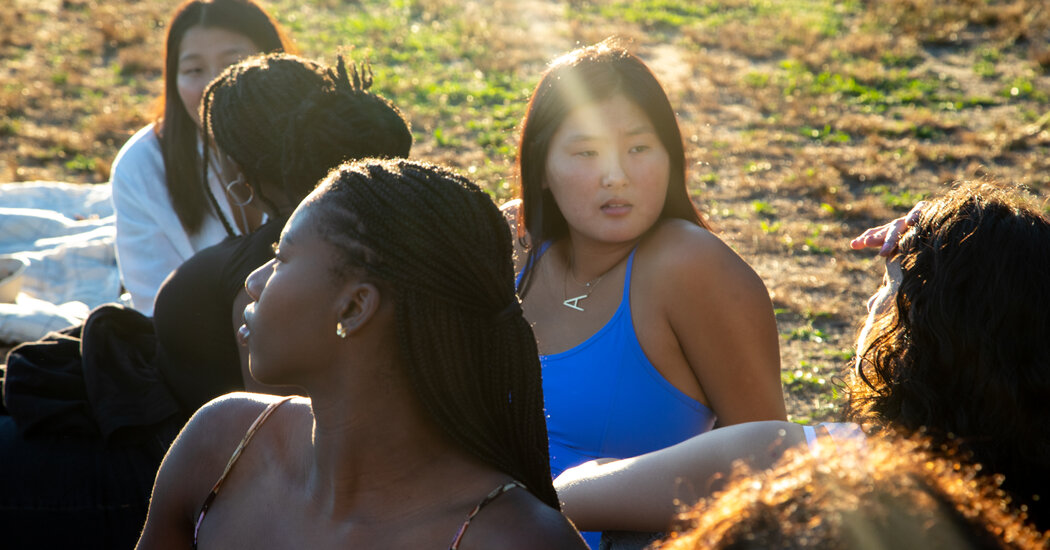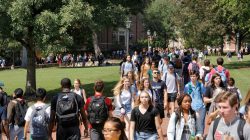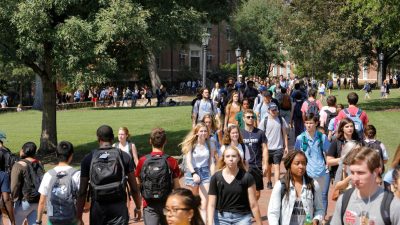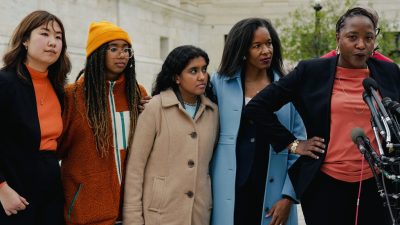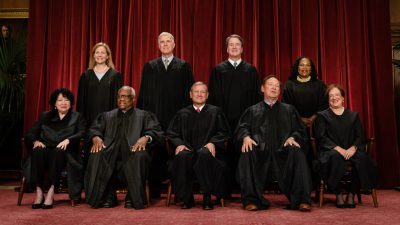In the early months of the coronavirus pandemic, Ava Salzman, now a senior at Harvard, took a class on oral storytelling in times of crisis. Despite the awkwardness of an online setting, Ms. Salzman said she felt that she and her 19 classmates found refuge in their shared stories.
The experience, said Ms. Salzman, who is of Chinese descent, crystallized for her why affirmative action was “an essential step for creating a campus that fosters that sense of community.” Surrounded by people of various ethnic backgrounds, she and her classmates explored one another’s cultures and learned about themselves in the process.
At the conclusion of the class, she had switched her major to folklore and mythology. The trove of anecdotes she had collected — her ancestors’ work on the transcontinental railroad, a relative’s 15-year detention under the Chinese Exclusion Act, her grandmother’s activism in the civil rights movement — now form the spine of her senior thesis, a graphic novel about her family history.
“I was not very connected to my own Asian American identity before coming into college,” she said. But being in the presence of other Asian Americans, people of color “and everybody who has embodied their identity with pride and joy has brought me from a place of feeling very lost to feeling very found.”
Her view reflects a central element of the arguments the Supreme Court heard on Monday favoring the use of race-conscious admissions at the University of North Carolina and Harvard: namely, that diversity confers educational benefits. Affirmative action has long ignited fierce debate, and a decision that rules out the practice could signal a sea change in higher education.
The cases were brought by a group called Students for Fair Admissions; its challenge to Harvard accuses the college of discriminating against Asian American students. The college’s admissions process assigns applicants a subjective personal rating, and the group contends that Asian American applicants systematically received lower scores, pointing to an analysis it commissioned of tens of thousands of student records made public when the case reached federal court.
The Fate of Affirmative Action in America
Harvard has denied the accusation and has defended its consideration of race as a factor in admissions, in part by repeatedly citing a landmark Supreme Court decision in 1978 that upheld the constitutionality of race-conscious admissions programs.
In the controlling opinion, Justice Lewis F. Powell Jr. wrote that the “nation’s future depends upon leaders trained through wide exposure to the ideas and mores of students as diverse as this nation of many peoples.”
As evidence, Harvard has pointed to internal surveys in which 60 to 70 percent of students reported that their college experiences strengthened their ability to relate to “people of different races, nations and religions” and said they had “seriously questioned or rethought their beliefs about a race or ethnic group different from their own.”
Some academic research has found that diversity can increase racial understanding and improve critical-thinking skills. Skeptics, however, have argued that such beliefs are anecdotal and not empirically proven.
In a 2016 case that upheld an unusual affirmative action program at the University of Texas at Austin, dissenting justices criticized the lack of measurable outcomes. “How will a court ever be able to determine whether stereotypes have been adequately destroyed? Or whether cross-racial understanding has been adequately achieved?” they asked.
Students for Fair Admissions has asserted that heralding purported educational results could reinforce stereotypes, treating “underrepresented minorities not as the beneficiaries of racial preferences, but as instruments to provide educational benefits for other, mostly white students.”
It is not alone in its criticisms.
“Affirming race says you need a boost because your race means you start off lower than others. Well, that seems mildly racist,” Michelle Gao, then a student, wrote in a 2018 opinion column in The Harvard Crimson, instead advocating greater consideration on socioeconomic status.
In a recent Pew Research Center survey, nearly 75 percent of American adults said that race or ethnicity should not be a factor in college admissions, with a majority of Black, Hispanic and Asian respondents opposing those considerations entirely.
Interviews that The Times conducted with a dozen undergraduates at Harvard reflected many of those nuances even as they supported the college’s consideration of race it its admissions process. Their views, while only a snapshot of a sliver of the undergraduate population here, offer insights from some of those whose experiences are at the heart of the trade-offs being weighed by the Supreme Court.
Hearing that Harvard’s admissions process assigned Asian applicants lower “personal ratings” was certainly hurtful, Ms. Salzman said, but not something that could be addressed by eliminating race as an admissions criterion.
“This kind of anti-Asian sentiment is something that is a much deeper problem and maybe has less to do with affirmative action and has more to do with the way we share these stories and treat internalized stereotypes,” she said.
Many said that race should be a consideration and that the college’s current admissions process had enhanced their undergraduate experience, particularly in social settings. Such statements are borne out by research and polling showing that students believed that diversity improved their social experience more so than their learning environments.
And many framed the need for diversity as a matter of equity, a worthwhile goal in and of itself and not something that necessarily needed to provide material benefits.
“In the ideal world, I don’t think that race should be considered in admissions because in the ideal world everyone has access to the same kind of resources,” said Primo Lagaso Goldberg, a sophomore from Hawaii who is Black and Filipino. “But that’s fundamentally not true.”
If anything, the students said, Harvard should intensify its commitment to diversity by admitting students with more varied socioeconomic and regional backgrounds, applying its principles of inclusion to faculty and improving facilities and resources for minority students.
The class of 2026 is 14.4 percent Black, 27.6 percent Asian American, 11.9 percent Hispanic or Latino and 3.6 percent Native American or Hawaiian — the most diverse group admitted yet.
Many of the students of color who spoke with The Times said that coming to such a campus opened a process of introspection. Those observations bolster existing academic research that has found that interacting with classmates of different cultures and races can enhance personal development for students of all backgrounds.
At his predominantly white high school in Toronto, Andrew de Souza, 21, who is of South Asian descent, recounted classmates mocking the way he smelled and looked.
“They were all the quote-unquote cool kids, so if you want to be invited to parties, to their chalets — and these are your quote-unquote friends — so you have to accept it and go along with it,” said Mr. de Souza, who is now a senior. “You swallow that, and it becomes way deeper, and it takes years and reflection and searching to break away from those barriers.”
At Harvard, when he joined a group for South Asian men to mentor one another, Mr. de Souza slowly stopped “actively rejecting my heritage.”
For some students of color, the importance of diversity became apparent through the very lack of it.
Alannah Hill, 21, a senior from Chicago, described a teaching assistant who constantly confused her with the only other Black student in the class even though “we look very different,” with dissimilar skin tones, hair and clothes. While some classmates noticed the mix-up, Ms. Hill said her professor seemed unbothered when the two students raised the issue.
Experiences like these, students said, underscored the need for Harvard to foster different types of diversity and to support students from racial and ethnic minorities. For example, Anoushka Chander, 19, a sophomore from Davis, Calif., noted that Hindu and Muslim students do not have a dedicated space to gather for prayer and religious activities and are instead confined to basements of dormitories.
More than one student joked about how elite boarding schools and affluent East Coast counties were the most overrepresented cohorts. “I know two or three other people from Arkansas, versus I can name off the top of my head 15 people from Westchester,” said Anh Cao, 21, a sophomore from Arkansas.
And more than one complained that Harvard’s commitment to diversity did not seem to translate to the faculty. White men account for 57 percent of tenured faculty and minorities about 21 percent, according to the school.
The school has paid a lot of attention to “visible representation,” said Elaine Jiwon Kim, a senior from London and Seoul. “But I have felt tokenized on so many occasions. I’d be asked to speak at an event for the freshmen or for visitors about projects that I’ve done. They’ll talk about how my identity factors into everything. But I look and the people who are celebrating these things would all be white men talking about the importance of diversity on campus.”
Arguments about winners and losers among different ethnic groups, the students said, ignored that the current process at least tries to rectify Harvard’s past discrimination. A 2022 report from the school documented its historical ties to slavery, resistance to integration and its role in disseminating bogus theories of racial differences.
In one conversation, students emphatically rejected what they characterized as a common talking point about Black and Latino applicants gaining admission at the expense of others.
Devine Bauman, 21, a junior from Minnesota who is half Black, was particularly incensed at the argument. “Whose spots are we taking? Show me the names,” she said.
She added that she never felt that “Harvard was just a place for people who were academically gifted.”
“They take you in the entire context of where and who you are,” she said.
Sumber: www.nytimes.com
